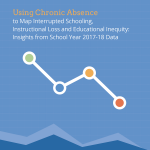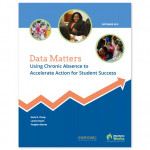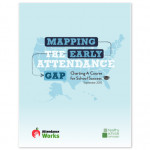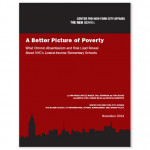Below is a list of seminal research related to attendance
For the full list of research and reports, please visit the All Research page.
Using Chronic Absence to Map Interrupted Schooling, Instructional Loss and Educational Inequity
Using Chronic Absence to Map Interrupted Schooling, Instructional Loss, and Educational Inequity: Insights from School Year 2017-18 Data, by Attendance Works and the Everyone Graduates Center, February 2021. This report provides a national and state analysis of how many schools face high levels of chronic absence and shows how chronic absence data reported prior to the coronavirus pandemic can help…
Data Matters: Using Chronic Absence to Accelerate Action for Student Success
Data Matters Using Chronic Absence to Accelerate Action for Student Success, by Hedy N. Chang, Lauren Bauer and Vaughan Byrnes, September 2018. This report provides a national and state analysis of how many schools face high levels of chronic absence and discusses the implications for state and local action. Based on data released by the U.S. Department of Education’s Office…
Portraits of Change: Aligning School and Community Resources to Reduce Chronic Absence
This report, Portraits of Change: Aligning School and Community Resources to Reduce Chronic Absence, by Attendance Works and the Everyone Graduates Center, September 2017, provides a national and state analysis of how many schools face high levels of chronic absence and discusses the implications for state and local action.
Preventing Missed Opportunity: Taking Collective Action to Confront Chronic Absence
Attendance Works and Everyone Graduates Center, September 2016. This brief builds on the first national chronic absence data from the U.S. Department of Education’s Civil Rights Data Collection from the 2013-14 school year. The analysis finds that half of the 6.5 million students who are chronically absent nationwide are concentrated in just 4 percent of school districts. The analysis also…
Mapping the Early Attendance Gap: Charting a Course for Student Success
This report shows how disparities in school attendance rates starting as early as preschool and kindergarten are contributing to achievement gaps and high school dropout rates across the country. The report also highlights the connection between health and attendance and the power of states to tackle absenteeism by tapping key champions, leveraging data, and learning from places that have improved…
A Better Picture of Poverty: What Chronic Absenteeism and Risk Load Reveal About NYC’s Lowest-Income Elementary Schools
Nauer, Kim. Center for New York City Affairs at the New School, November 2014. This report looks closely at New York City’s schools and documents the risk factors that plague struggling schools. Researchers found that more than 87,000 New York City children from kindergarten through third grade missed 10 percent or more of the school year in 2012-13. That number…
Absences Add Up: How School Attendance Influences Student Success
Ginsburg, Alan, Phyllis Jordan and Hedy Chang. Attendance Works, August 2014. This state-by-state analysis of national testing data demonstrates that students who miss more school than their peers consistently score lower on standardized tests, a result that holds true at every age, in every demographic group, and in every state and city tested. The analysis is based on the results…






